
Journal of Science and Transport Technology Vol. 4 No. 1, 1-12
Journal of Science and Transport Technology
Journal homepage: https://jstt.vn/index.php/en
JSTT 2024, 4 (1), 1-12
Published online 22/03/2024
Article info
Type of article:
Original research paper
DOI:
https://doi.org/10.58845/jstt.utt.2
024.en.4.1.1-12
*Corresponding author:
Email address:
doannc@utt.edu.vn
Received: 27/01/2024
Revised: 19/03/2024
Accepted: 19/03/2024
Efficiency Evaluation of Using Water-Fuel
Emulsion as Fuel for Automobiles
Hiep Ha Nguyen1, Doan Cong Nguyen2,*, Thanh Le Nguyen3
1Le Quy Don Technical University, 236 Hoang Quoc Viet, Hanoi, Vietnam;
hahiepshippower@lqdtu.edu.vn
2University of Transport Technology, 54 Trieu Khuc, Thanh Xuan, Hanoi,
Vietnam, doannc@utt.edu.vn
3Air Force Officer's College, No.03 - Villa Street, Tan Lap Ward, Nha Trang City,
Khanh Hoa, Vietnam; thanhmbdc@gmail.com
Abstract: Road transport is the main consumer of petroleum fuel as well as a
source of toxic substances. Therefore, reducing fuel consumption and
emissions of harmful substances in road transport is one of the most important
problems facing modern engine construction. One of the ways to solve this
problem is through the use of mixed fuels, including water-fuel emulsions.
Water-fuel emulsion is a promising alternative fuel that could fulfill such
requests in that it can improve the combustion efficiency of internal combustion
engines and reduce harmful exhaust emissions, especially nitrogen oxide
(NOx) and particulate matter (PM). Up to now, there have been many studies
on water-fuel emulsions, especially on performance, emissions and micro-
explosion phenomena. Using water-fuel emulsion as fuel for ships worldwide
was studied and applied to the 80-ies of the last century, but using it for
automobiles is still limited by the emulsion stability and economic difficulties to
calibrate engine parameters for a new fuel. This article provides an overview
of the mechanism and performance operating cycle of internal combustion
engines using water-fuel emulsions and the efficiency, economy, and
environmental friendliness of this fuel type for automobiles. Hence, conclusions
are drawn about the possibility and effectiveness of using emulsions as fuel for
automobiles, especially under conditions in Vietnam.
Keywords: water-fuel emulsion, water-diesel, fuel consumption, power,
efficiency, economy, exhaust emissions.
1. Introduction
Internal combustion engines (ICE), including
gasoline and diesel engines, are used as the
primary source of propulsion in mobile vehicles,
including automobiles. For mobile vehicles, such
as automobiles and cars, fuel costs account for
about 70% of the total investment cost throughout
the engine's working cycle [1]. Therefore, in
automobile operations, saving fuel is always an
urgent issue.
Currently, there are many research options
for using cheaper alternative fuels for vehicles such
as natural gas [2], liquefied petroleum gas [3],
biodiesel [4],[5], alcohol [5],[6], dimethyl ether [7]-
[9], and hydrogen [10],[11]. However, using
petroleum fuels (gasoline, diesel) for vehicles
usually takes several decades but will continue to
be the main focus.
The use of water in the working process of
ICEs using petroleum fuels began almost

JSTT 2024, 4 (1), 1-12
Nguyen et al
2
simultaneously with their appearance. Back in
1864, Hugon supplied water to the combustible
mixture to improve the performance of Lenoir's
engine [12]. In the 1930s, water injection began to
be used in high-speed engines to increase the
compression ratio (prevent detonation
combustion), increase the ICE's power, and reduce
engine parts' temperature. Based on [13]-[22]
several methods have been developed for
supplying water to engine cylinders (Fig 1). It is
possible to supply water to the engine cylinders in
the liquid phase or the form of steam. The supply
of water vapor to ICEs can be implemented in
power plants with a heat recovery circuit (exhaust
gas heat, cooling water, lubricating oil) removed
from the engine and used to heat water and
evaporate it. For high-speed vehicle engines, it is
preferable to supply water to the combustion
chamber in the liquid phase. The following
methods have found the most significant practical
application: (1) Injecting water directly into the
cylinders using water-fuel emulsion as fuel, and (2)
supplying water into intake pipelines (manifolds).
The mixture made up of water and fuel is
called an emulsion. There are two emulsions:
"water in fuel" and "fuel in water". In practice, the
first emulsion type, called "water-fuel emulsion"
(WFE), is mainly used, in which water accounts for
about 10 ÷ 40% of the mixture volume and is
broken down to micro or nano size [23]. Using
emulsion as fuel for vehicles can be done by two
methods: the first is to use a pre-made emulsion,
and the second is to use an emulsion created
directly on the automobiles.
Fig 1. Methods for supplying water to engine cylinders
Experience using emulsion as fuel for ships
has been researched and applied worldwide since
the 80s of the last century [13],[23]-26]. However,
its use in automobiles still needs to be improved
due to some exploitation problems with techniques
and technology, especially under conditions in
Vietnam. First, due to the complexity of creating
emulsions, their stability, and the inability to
maintain long-term emulsion quality when using
pre-made emulsions, the complexity of using under
cold conditions, low-temperature conditions,
expensive water-in-fuel mixing equipment, as well
as the complexity of adjusting the ratio between
water and fuel to obtain an emulsion mixture with
optimal composition for different working
conditions of the engine. Second, some practical
and theoretical issues in studying the influence of
water on the working process in engines have yet
to be thoroughly researched.
Using water as a fuel component affects the
engine's power and economy. On the one hand,
the loss of part of the heat to drying and

JSTT 2024, 4 (1), 1-12
Nguyen et al
3
evaporation of water leads to a decrease in the
above parameters. On the other hand, due to the
formation of active radicals when creating a
mixture in the engine cylinder and the "micro-
explosion" phenomenon of nano-sized water
particles, it increases the speed of chain reactions,
increasing the turbulence of the engine mixture so
the fuel burns more completely [27]-29]. The
mechanism of the "micro-explosion" phenomenon
is represented in Fig 2 [29]. The cooling effect of
water also improves the quality of air intake into the
cylinder, reducing thermal-mechanical stress on
engine combustion chamber parts, improving anti-
knock properties of gasoline, reducing NOx and
CO emissions concentrations; it increases power,
fuel economy, engine longevity, and automobile
mileage [30].
Fig 2. The mechanism of the micro-explosion
phenomenon
In recent years, interest in water use in the
form of WFEs increased, opening up broader
prospects than using water only as a depressive
medium. This method of improving ICE
performance is implemented in gasoline and diesel
engines. In both cases, in most operating modes,
the processes of mixture formation and combustion
are improved, the emission of nitrogen oxides is
reduced, and the thermal stress of engine parts is
significantly reduced. At the same time, when water
is supplied to the cylinders of a gasoline engine, a
deterioration in some of its indicators is observed
in some cases. In particular, in partial load modes,
excessive cooling of the working mixture due to the
evaporation of water leads to insufficient
homogenization of the mixture, deterioration in the
quality of the work process, and an increase in the
duration of vehicle acceleration. The best results
are obtained by supplying water to diesel engines'
cylinders, ensuring high-quality mixture formation,
and the smokiness of exhaust gases is noticeably
reduced.
Thus, supplying a certain amount of water to
the combustion chamber is one of the effective
methods for improving the economic and
environmental performance of diesel engines.
Currently, water supply to the cylinders is widely
used in marine diesel engines. Injecting WFE into
the combustion chamber of these engines makes it
possible to solve the problems of increasing the
operational fuel efficiency of a ship's power plant,
improving its environmental performance, reducing
thermal stress, and using viscous fuels. Research
is being conducted on using WFE in diesel
locomotives and stationary diesel engines. The
increased interest in supplying water to the
cylinders of high-speed diesel engines for
automotive use is due to the possibility of a
noticeable improvement in the toxicity of their
exhaust gases [31]-33].
The article presents an overview of the
history of using emulsions as fuel, analyzes the
basis of working cycle theory using emulsions as
fuel, and explores some results using emulsion.
From there, conclusions are drawn about the
possibility and effectiveness of using emulsions as
fuel for cars, especially under climatic conditions in
Vietnam.
2. Brief history of the using emulsions as fuel
In 1920-1921, two-compartment carburetors
were installed on many British buses. One
compartment is for the fuel supply, and the other is
for the water supply [12]. In the 1930s, water was
of interest to aeronautical technicians. In some
studies, the use of water not only improves anti-
knock properties but also reduces aviation engine
heat load. In the Soviet Union, experiments were
conducted on test benches as well as on the road

JSTT 2024, 4 (1), 1-12
Nguyen et al
4
when spraying water into the intake manifold of car
engines ZIS-150 and ZIS-151, as well as the bus
ZIS-155, here instead of using indexed gasoline 66
octane is equal to 56 octane gasoline [34].
During World War II, water injection was used
on fighter aircraft and bombers produced in the
Soviet Union, Germany, and the United States. For
example, water injection was applied to the V12
engine installed on the B-29 bomber [34]. This
research direction was implemented for the first
time at NASA. Then, based on the research, Rolls
Royce successfully manufactured an aviation
engine with water injection applications.
Engine enhancement by water injection (or
water-alcohol mixture) was commonly used during
World War II by American (Pratt & Whitney) and
German (Daimler Benz and BMW) engine
manufacturers. Water is added to the fuel-air
mixture, and the entire mixture is injected into
engine cylinders. Due to contact with the hot
surface of the piston and cylinder wall, water
quickly turns into steam, creating favorable
conditions for the combustion process. Cooling the
fuel-air mixture increases the amount of mixture
injected and improves fuel combustion efficiency.
The French automobile manufacturing group
"Renault" has been applying water injection to fuel
since 1977 (water injection) on racing automobiles.
In 1983, during the World Automobile
Championship “Formula-1” “Renault” installed a
12-liter water tank, an electric pump, and a
pressure regulator, which increased engine power
up to 440 kW. In 1986, the power of this engine was
increased to 640 kW. In 1983, the Italian company
“Ferrari" also applied water injection, which used a
mixture of alcohol and water. Then, the German
automobile company “Porsche” also applied water
injection to "Formula-1" automobiles to increase
engine power [34]. In the early 1980s, on racing
motorcycles from Harley-Davidson, Suzuki, BMW,
Honda, and Kawasaki, water injection was applied
to reduce the heat load on the engine because the
heat load on racing motorcycles was very high, if
water is not sprayed, the motorcycles often stop
working [35]. After that, the water injection method
was no longer used because the world's fuel
exploitation increased significantly, and fuel prices
decreased significantly.
Domestically, since 2009, several scientists
from the Department of Science and Technology of
Ho Chi Minh City have initially researched. In early
2011, the Department of Science and Technology
of Ho Chi Minh City announced that they had
successfully tested equipment production to create
emulsions from mixtures. Combining diesel fuel
and water used for engines helps save fuel and
reduce environmental pollution emissions [35].
Researchers continue to perfect the design to be
applied to Ho Chi Minh City buses.
3. Analysis of the theoretical basis of using
emulsions as fuel
At Cooling the engine cylinders with water
increases the engine's power and efficiency. The
cooling effect depends on the heat of vaporization
and evaporation conditions of the fuel. The heat of
vaporization of water is 2260 kJ/kg, while that of
alcohol is 860 kJ/kg, and that of gasoline is 315 -
350 kJ/kg [29]. Therefore, if using alcohol entirely
or a mixture of alcohol with gasoline or fuel with
water, it means the alternative fuel has a higher
heat of vaporization than gasoline, requiring less
oxygen to burn, improving cooling efficiency. Water
reduces not only the temperature of engine parts
but also the temperature of the fuel-water mixture.
Water injection affects combustion chemical
reactions, thereby reducing the fuel combustion
temperature. The result is reduced nitrogen oxide
and carbon concentrations in the exhaust gas.
When using emulsion as fuel, the disadvantage is
that the HC concentration in the exhaust gas
increases. In some mining cases, the engine works
unstable when the car moves at low speed. It is
related to the uneven distribution of water to the
engine cylinders.
Along with experimental studies related to
water use in engines, many studies clarify the role

JSTT 2024, 4 (1), 1-12
Nguyen et al
5
of steam in the combustion process. When water
participates in the combustion process, it affects
the fire spread speed and enhances the conversion
of CO into CO2. It is pronounced when the water
concentration is 7 - 9% [37]-[39]. As the water
concentration continues to increase, the process
speed decreases because of the decrease in
combustion temperature.
To analyze more clearly, build a theoretical
basis to calculate the working cycle thermal
efficiency of diesel engines with the following
assumptions:
- The evaporation of water in the emulsion
takes place instantaneously at the end of the
isovolumic heating process;
- The water vapor concentration in the
working medium is small (less than 1%) and does
not affect the working cycle parameters.
On that basis, the ideal working cycle of a
diesel engine is shown in Fig 3. The formulas below
consider the working cycle of 1 kg of working fluid.
Fig 3. Ideal working cycle of a diesel engine using
emulsion as fuel. 1-2: adiabatic compression; 2-3':
isovolumetric heat supply; 3'-3: isovolumic heat
release; 3-4: isobaric heat supply; 4-5: adiabatic
expansion; 5-1: isovolumic heat release; q1, q2 are
isovolumetric and isobaric specific heat, kJ/kg,
respectively; q3, qs are the amount of specific heat
released isovolumically and released by
evaporation, kJ/kg, respectively; Vc, Va -
combustion chamber volume and total volume.
Thermal efficiency of the working cycle is
determined as follows:
1 3 2 3
12
1
()
w w wp
a
t
q i i m L q q
L
qq
− − + + −
=+
(1)
Where i3 is the enthalpy of water vapor at
point 3, kJ/kg; iw is the enthalpy of water injected
into the engine cylinder, kJ/kg; mw is the mass of
water in the emulsion, kg/kg; La = αL0 is the actual
mass of air needed to burn 1 kg of fuel, kg/kg; α is
the excess air coefficients; L0 is the theoretical air
mass to burn 1 kg of fuel, kg/kg; Lwp is theoretical
work done by steam after 1 work cycle, kJ/kg.
The theoretical work done by steam after 1
working cycle is determined as follows:
( )
35
1
wp w
a
L i i m L
=−
(2)
where i5 is the enthalpy of the gas mixture in
the cylinder at point 5, kJ/kg.
From (1) and (2) we have:
35
12
1
()
1
ww
a
t
q i i m L
qq
+−
=− +
(3)
The equation (3) is used to determine ηt at
the rated working mode of engine when using
traditional diesel fuel (mw = 0) and WFE (mw ≠ 0).
From (3), we see that ηt decreases as mw
increases. Therefore, it is not possible to use the
theory of engine working cycle to analyze the
efficiency of using water as a fuel component, but
we need to use combustion models to determine
the burning velocity and heat release rate of the
medium.
Due to the presence of free radicals,
chemical reaction speeds occur faster, so the
combustion delay time when using emulsion as
fuel is reduced compared to traditional diesel. The
burning velocity is determined according to the
two-component formula of I.I. Vibe [39], in which
the dynamic combustion and diffusion combustion
characteristics parameters, when applied to
emulsion fuels, need to be determined
experimentally.

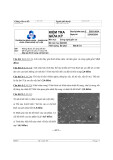
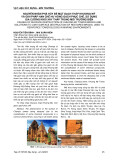


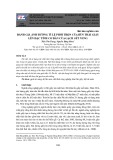


![Bài giảng Quản lý vận hành và bảo trì công trình xây dựng [chuẩn nhất]](https://cdn.tailieu.vn/images/document/thumbnail/2025/20251006/agonars97/135x160/30881759736164.jpg)


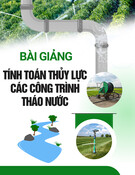
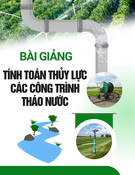
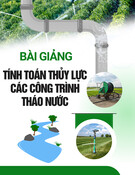
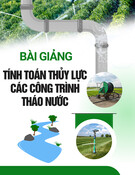
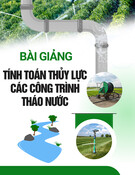
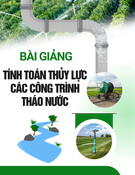

![Ngân hàng câu hỏi trắc nghiệm Sức bền vật liệu 1: [Mô tả/Định tính Thêm để Tăng CTR]](https://cdn.tailieu.vn/images/document/thumbnail/2025/20250920/kimphuong1001/135x160/6851758357416.jpg)


![Trắc nghiệm Kinh tế xây dựng [chuẩn nhất]](https://cdn.tailieu.vn/images/document/thumbnail/2025/20250920/kimphuong1001/135x160/32781758338877.jpg)

